E-Commerce System Design Document Report: Functional & Non-Functional
VerifiedAdded on 2022/11/11
|25
|4711
|192
Report
AI Summary
This design document details the architecture and components of an e-commerce system. It outlines the project's aim to create a platform connecting sellers and purchasers for online transactions, emphasizing data management and user-friendliness. The report covers functional requirements such as user registration, login, and order processing, along with non-functional requirements like security, reliability, and usability. The system design includes design goals, system behavior, logical views, and a class diagram. The document also addresses project management aspects like risk management and traceability, offering a comprehensive overview of the e-commerce system's development and implementation. The system utilizes ASPX/Microsoft C# .NET web technologies and MySQL Server for the database.
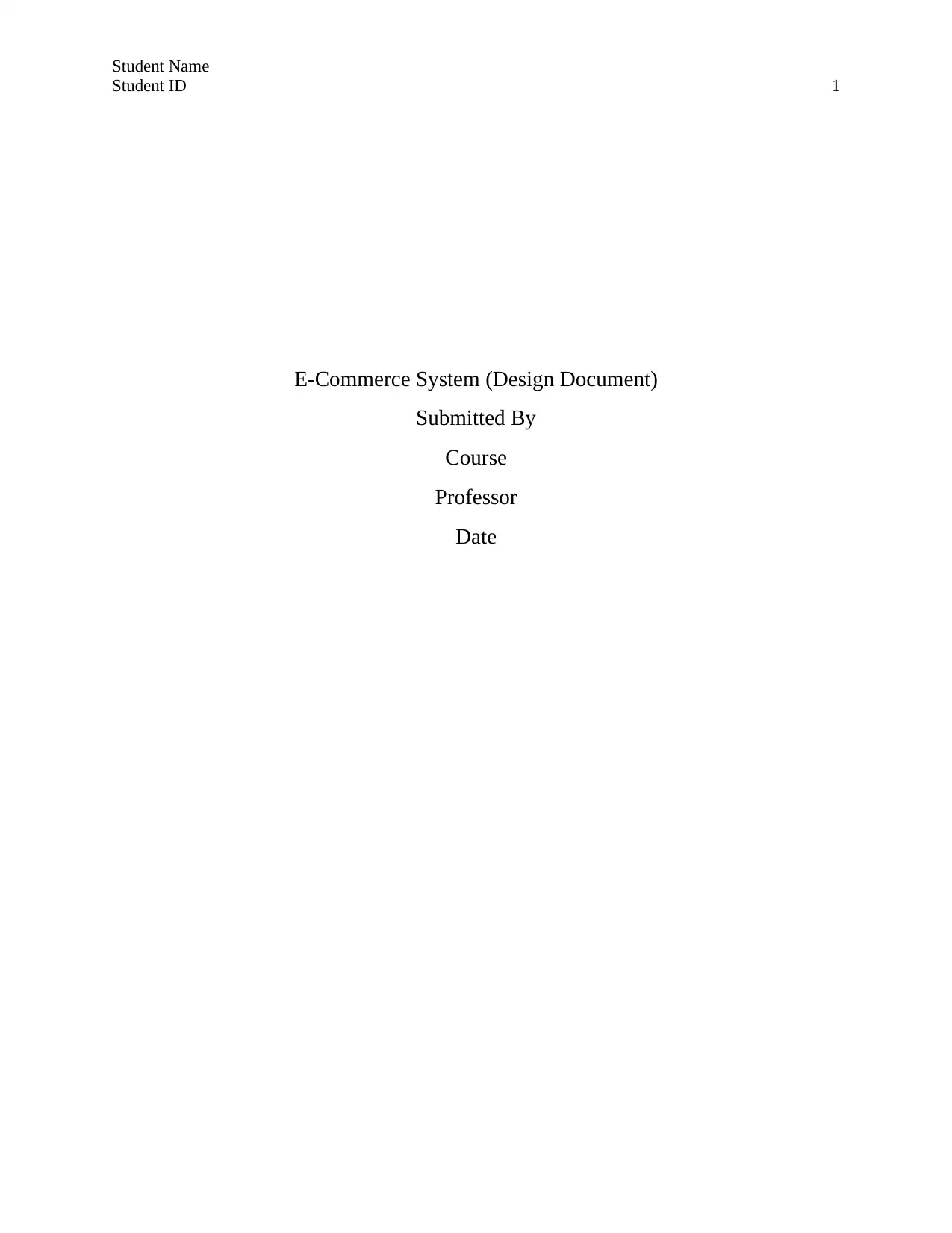
Student Name
Student ID 1
E-Commerce System (Design Document)
Submitted By
Course
Professor
Date
Student ID 1
E-Commerce System (Design Document)
Submitted By
Course
Professor
Date
Paraphrase This Document
Need a fresh take? Get an instant paraphrase of this document with our AI Paraphraser
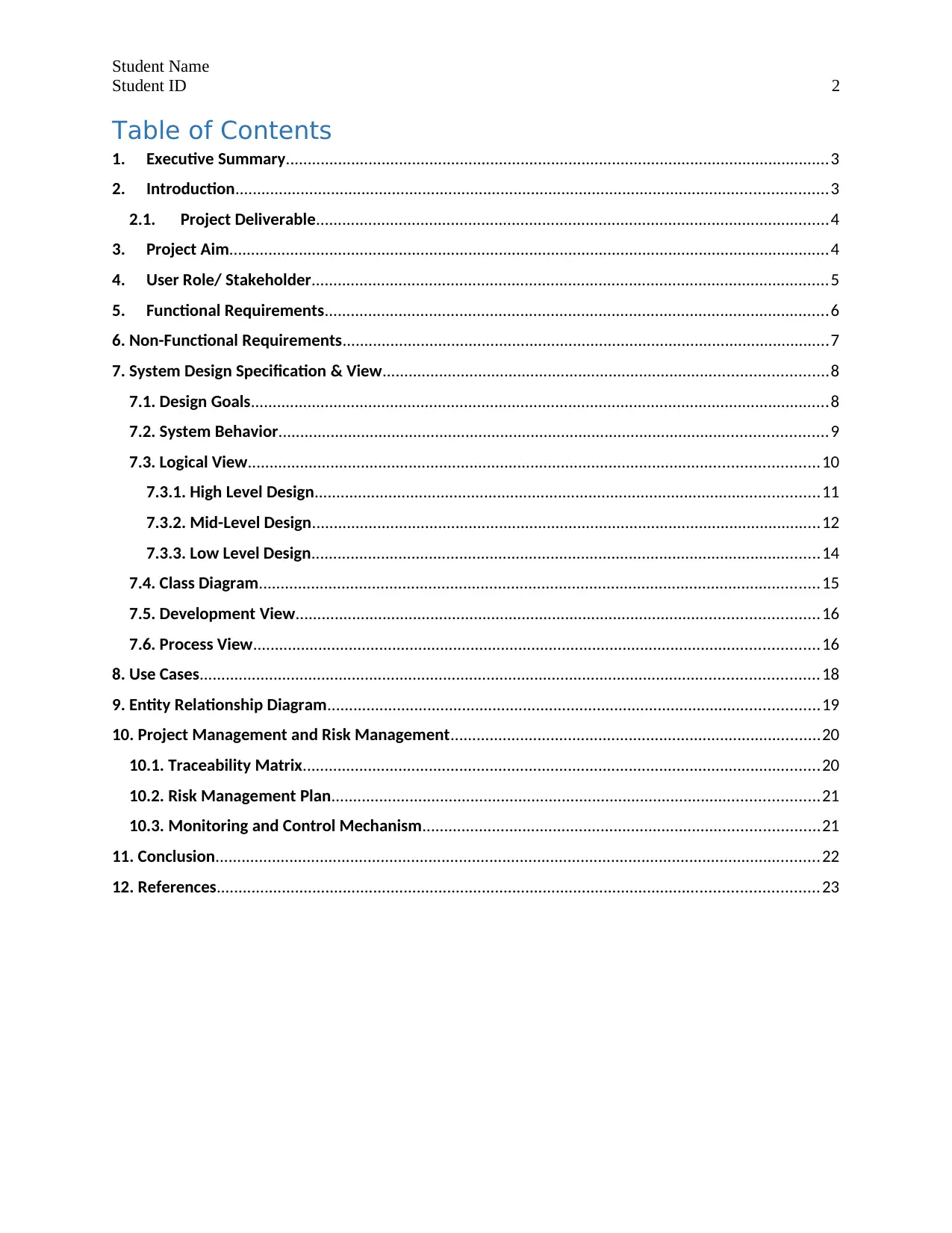
Student Name
Student ID 2
Table of Contents
1. Executive Summary.............................................................................................................................3
2. Introduction........................................................................................................................................3
2.1. Project Deliverable......................................................................................................................4
3. Project Aim..........................................................................................................................................4
4. User Role/ Stakeholder.......................................................................................................................5
5. Functional Requirements....................................................................................................................6
6. Non-Functional Requirements................................................................................................................7
7. System Design Specification & View......................................................................................................8
7.1. Design Goals.....................................................................................................................................8
7.2. System Behavior..............................................................................................................................9
7.3. Logical View...................................................................................................................................10
7.3.1. High Level Design....................................................................................................................11
7.3.2. Mid-Level Design.....................................................................................................................12
7.3.3. Low Level Design.....................................................................................................................14
7.4. Class Diagram.................................................................................................................................15
7.5. Development View........................................................................................................................16
7.6. Process View..................................................................................................................................16
8. Use Cases..............................................................................................................................................18
9. Entity Relationship Diagram.................................................................................................................19
10. Project Management and Risk Management.....................................................................................20
10.1. Traceability Matrix.......................................................................................................................20
10.2. Risk Management Plan................................................................................................................21
10.3. Monitoring and Control Mechanism...........................................................................................21
11. Conclusion...........................................................................................................................................22
12. References..........................................................................................................................................23
Student ID 2
Table of Contents
1. Executive Summary.............................................................................................................................3
2. Introduction........................................................................................................................................3
2.1. Project Deliverable......................................................................................................................4
3. Project Aim..........................................................................................................................................4
4. User Role/ Stakeholder.......................................................................................................................5
5. Functional Requirements....................................................................................................................6
6. Non-Functional Requirements................................................................................................................7
7. System Design Specification & View......................................................................................................8
7.1. Design Goals.....................................................................................................................................8
7.2. System Behavior..............................................................................................................................9
7.3. Logical View...................................................................................................................................10
7.3.1. High Level Design....................................................................................................................11
7.3.2. Mid-Level Design.....................................................................................................................12
7.3.3. Low Level Design.....................................................................................................................14
7.4. Class Diagram.................................................................................................................................15
7.5. Development View........................................................................................................................16
7.6. Process View..................................................................................................................................16
8. Use Cases..............................................................................................................................................18
9. Entity Relationship Diagram.................................................................................................................19
10. Project Management and Risk Management.....................................................................................20
10.1. Traceability Matrix.......................................................................................................................20
10.2. Risk Management Plan................................................................................................................21
10.3. Monitoring and Control Mechanism...........................................................................................21
11. Conclusion...........................................................................................................................................22
12. References..........................................................................................................................................23
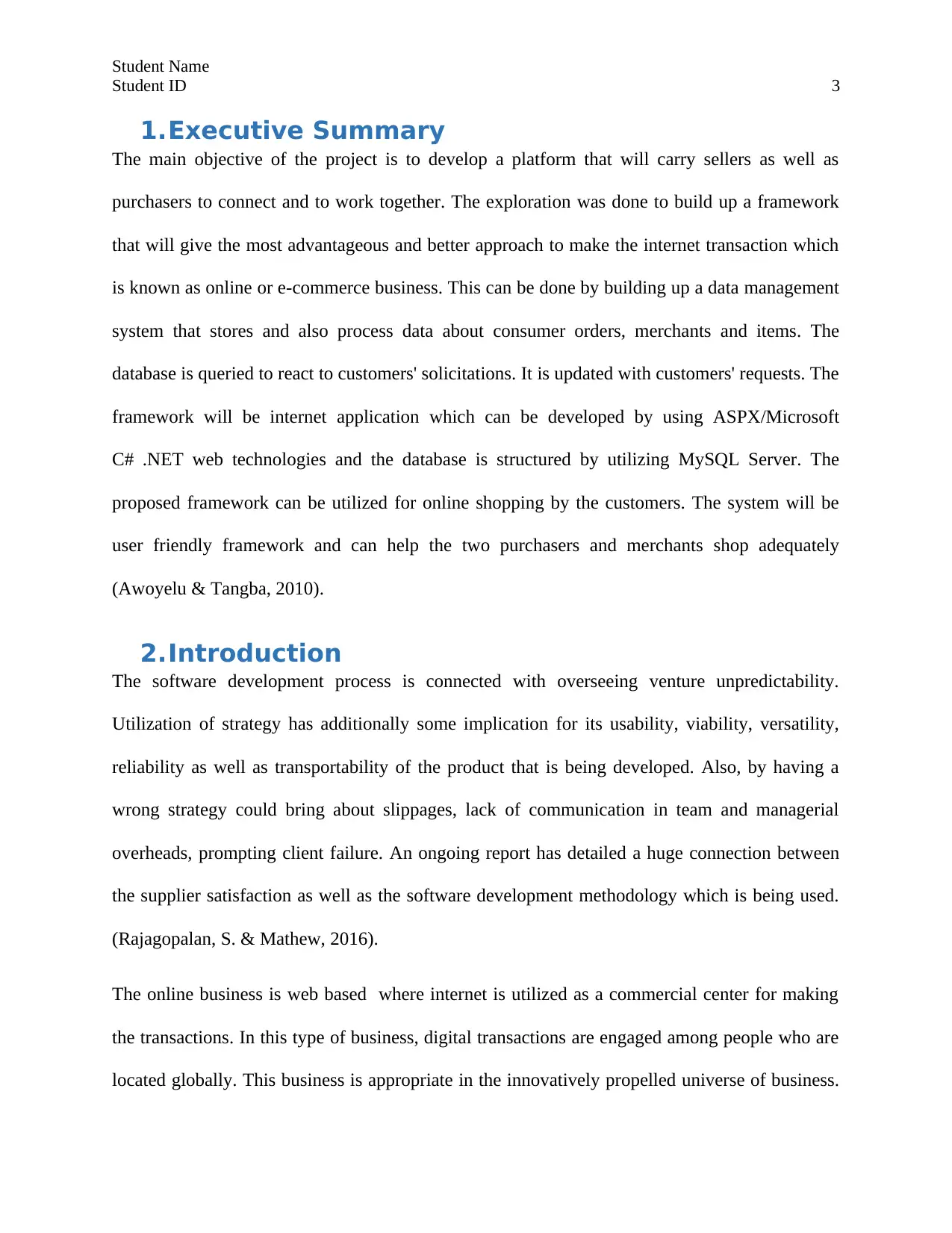
Student Name
Student ID 3
1.Executive Summary
The main objective of the project is to develop a platform that will carry sellers as well as
purchasers to connect and to work together. The exploration was done to build up a framework
that will give the most advantageous and better approach to make the internet transaction which
is known as online or e-commerce business. This can be done by building up a data management
system that stores and also process data about consumer orders, merchants and items. The
database is queried to react to customers' solicitations. It is updated with customers' requests. The
framework will be internet application which can be developed by using ASPX/Microsoft
C# .NET web technologies and the database is structured by utilizing MySQL Server. The
proposed framework can be utilized for online shopping by the customers. The system will be
user friendly framework and can help the two purchasers and merchants shop adequately
(Awoyelu & Tangba, 2010).
2.Introduction
The software development process is connected with overseeing venture unpredictability.
Utilization of strategy has additionally some implication for its usability, viability, versatility,
reliability as well as transportability of the product that is being developed. Also, by having a
wrong strategy could bring about slippages, lack of communication in team and managerial
overheads, prompting client failure. An ongoing report has detailed a huge connection between
the supplier satisfaction as well as the software development methodology which is being used.
(Rajagopalan, S. & Mathew, 2016).
The online business is web based where internet is utilized as a commercial center for making
the transactions. In this type of business, digital transactions are engaged among people who are
located globally. This business is appropriate in the innovatively propelled universe of business.
Student ID 3
1.Executive Summary
The main objective of the project is to develop a platform that will carry sellers as well as
purchasers to connect and to work together. The exploration was done to build up a framework
that will give the most advantageous and better approach to make the internet transaction which
is known as online or e-commerce business. This can be done by building up a data management
system that stores and also process data about consumer orders, merchants and items. The
database is queried to react to customers' solicitations. It is updated with customers' requests. The
framework will be internet application which can be developed by using ASPX/Microsoft
C# .NET web technologies and the database is structured by utilizing MySQL Server. The
proposed framework can be utilized for online shopping by the customers. The system will be
user friendly framework and can help the two purchasers and merchants shop adequately
(Awoyelu & Tangba, 2010).
2.Introduction
The software development process is connected with overseeing venture unpredictability.
Utilization of strategy has additionally some implication for its usability, viability, versatility,
reliability as well as transportability of the product that is being developed. Also, by having a
wrong strategy could bring about slippages, lack of communication in team and managerial
overheads, prompting client failure. An ongoing report has detailed a huge connection between
the supplier satisfaction as well as the software development methodology which is being used.
(Rajagopalan, S. & Mathew, 2016).
The online business is web based where internet is utilized as a commercial center for making
the transactions. In this type of business, digital transactions are engaged among people who are
located globally. This business is appropriate in the innovatively propelled universe of business.
⊘ This is a preview!⊘
Do you want full access?
Subscribe today to unlock all pages.

Trusted by 1+ million students worldwide
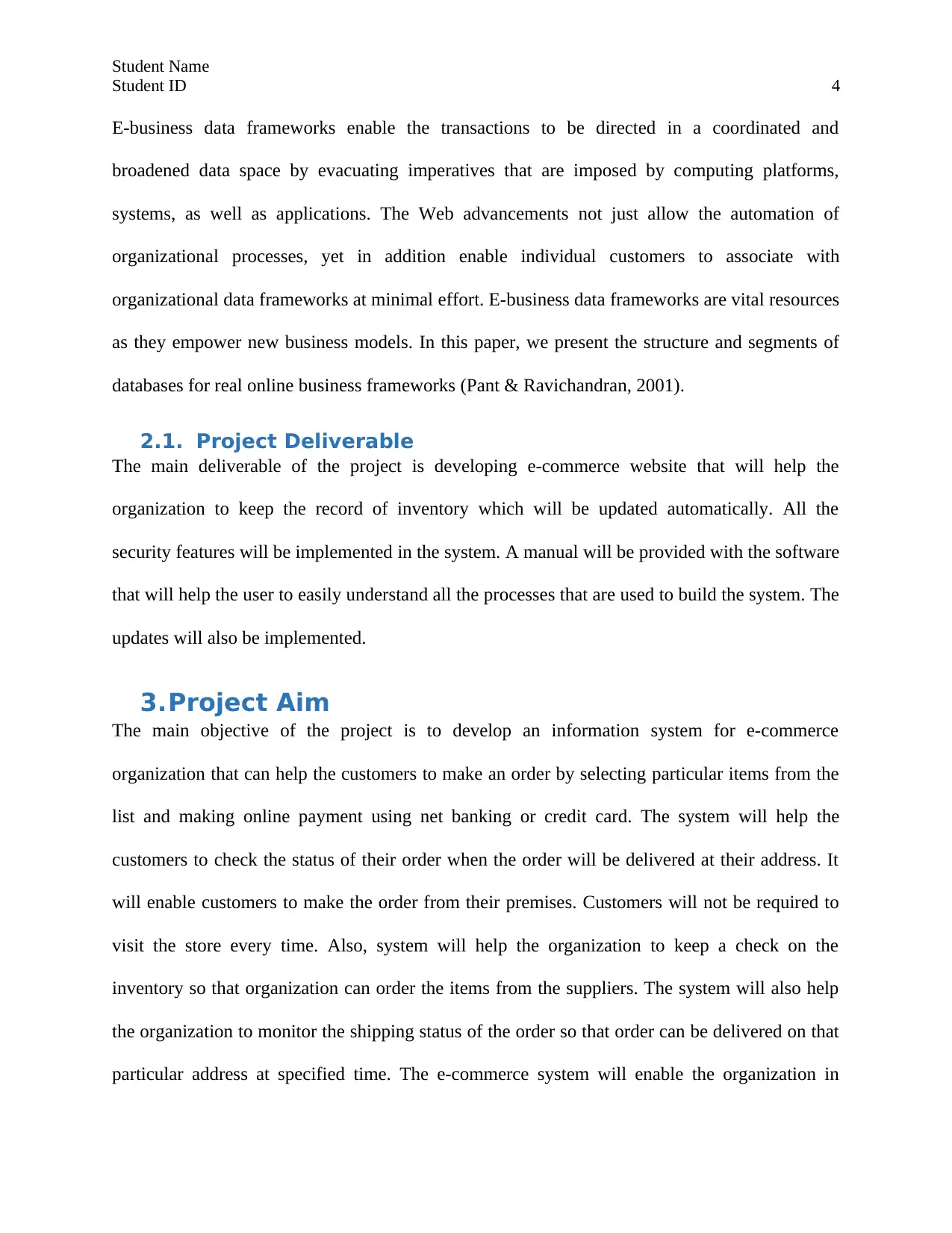
Student Name
Student ID 4
E-business data frameworks enable the transactions to be directed in a coordinated and
broadened data space by evacuating imperatives that are imposed by computing platforms,
systems, as well as applications. The Web advancements not just allow the automation of
organizational processes, yet in addition enable individual customers to associate with
organizational data frameworks at minimal effort. E-business data frameworks are vital resources
as they empower new business models. In this paper, we present the structure and segments of
databases for real online business frameworks (Pant & Ravichandran, 2001).
2.1. Project Deliverable
The main deliverable of the project is developing e-commerce website that will help the
organization to keep the record of inventory which will be updated automatically. All the
security features will be implemented in the system. A manual will be provided with the software
that will help the user to easily understand all the processes that are used to build the system. The
updates will also be implemented.
3.Project Aim
The main objective of the project is to develop an information system for e-commerce
organization that can help the customers to make an order by selecting particular items from the
list and making online payment using net banking or credit card. The system will help the
customers to check the status of their order when the order will be delivered at their address. It
will enable customers to make the order from their premises. Customers will not be required to
visit the store every time. Also, system will help the organization to keep a check on the
inventory so that organization can order the items from the suppliers. The system will also help
the organization to monitor the shipping status of the order so that order can be delivered on that
particular address at specified time. The e-commerce system will enable the organization in
Student ID 4
E-business data frameworks enable the transactions to be directed in a coordinated and
broadened data space by evacuating imperatives that are imposed by computing platforms,
systems, as well as applications. The Web advancements not just allow the automation of
organizational processes, yet in addition enable individual customers to associate with
organizational data frameworks at minimal effort. E-business data frameworks are vital resources
as they empower new business models. In this paper, we present the structure and segments of
databases for real online business frameworks (Pant & Ravichandran, 2001).
2.1. Project Deliverable
The main deliverable of the project is developing e-commerce website that will help the
organization to keep the record of inventory which will be updated automatically. All the
security features will be implemented in the system. A manual will be provided with the software
that will help the user to easily understand all the processes that are used to build the system. The
updates will also be implemented.
3.Project Aim
The main objective of the project is to develop an information system for e-commerce
organization that can help the customers to make an order by selecting particular items from the
list and making online payment using net banking or credit card. The system will help the
customers to check the status of their order when the order will be delivered at their address. It
will enable customers to make the order from their premises. Customers will not be required to
visit the store every time. Also, system will help the organization to keep a check on the
inventory so that organization can order the items from the suppliers. The system will also help
the organization to monitor the shipping status of the order so that order can be delivered on that
particular address at specified time. The e-commerce system will enable the organization in
Paraphrase This Document
Need a fresh take? Get an instant paraphrase of this document with our AI Paraphraser
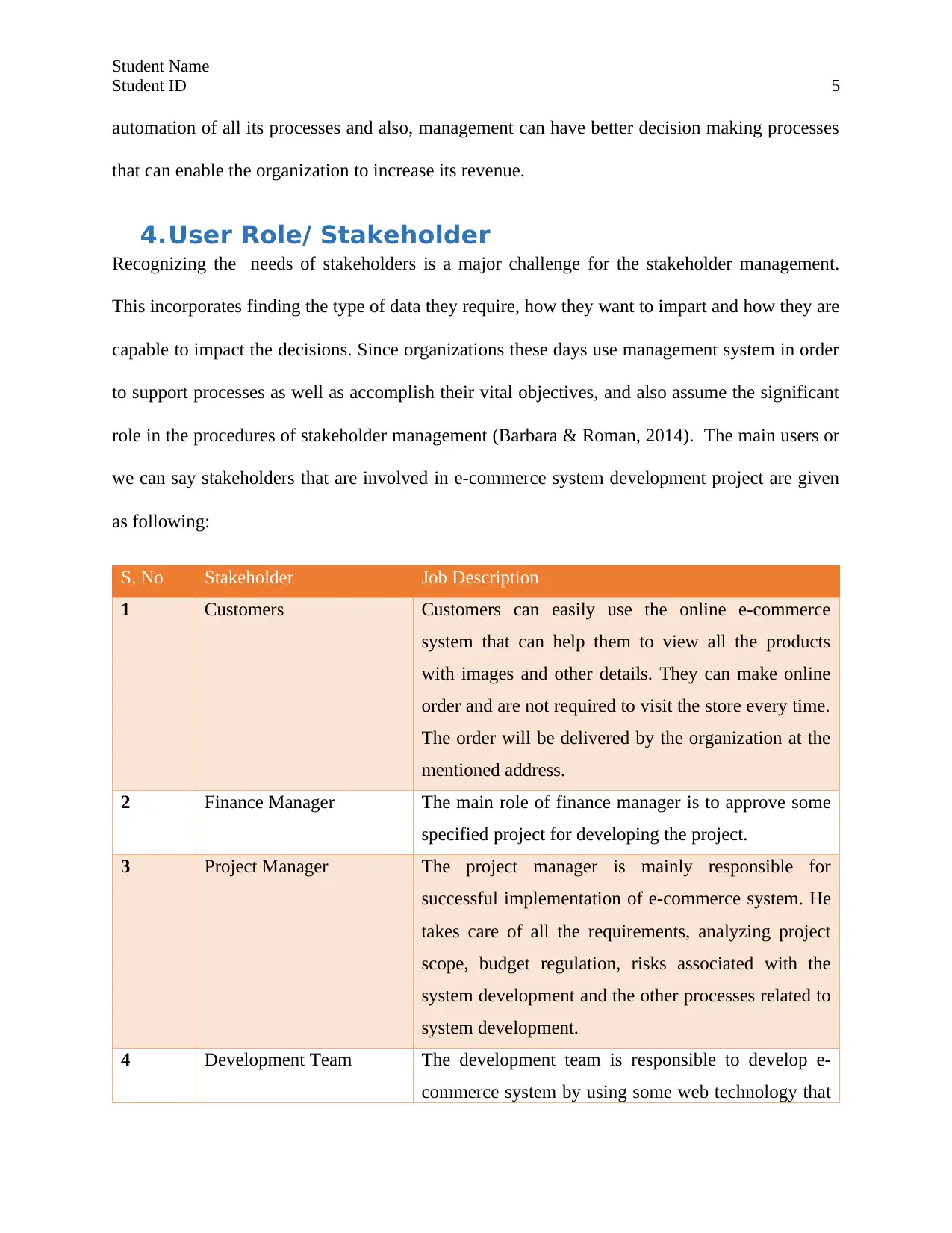
Student Name
Student ID 5
automation of all its processes and also, management can have better decision making processes
that can enable the organization to increase its revenue.
4.User Role/ Stakeholder
Recognizing the needs of stakeholders is a major challenge for the stakeholder management.
This incorporates finding the type of data they require, how they want to impart and how they are
capable to impact the decisions. Since organizations these days use management system in order
to support processes as well as accomplish their vital objectives, and also assume the significant
role in the procedures of stakeholder management (Barbara & Roman, 2014). The main users or
we can say stakeholders that are involved in e-commerce system development project are given
as following:
S. No Stakeholder Job Description
1 Customers Customers can easily use the online e-commerce
system that can help them to view all the products
with images and other details. They can make online
order and are not required to visit the store every time.
The order will be delivered by the organization at the
mentioned address.
2 Finance Manager The main role of finance manager is to approve some
specified project for developing the project.
3 Project Manager The project manager is mainly responsible for
successful implementation of e-commerce system. He
takes care of all the requirements, analyzing project
scope, budget regulation, risks associated with the
system development and the other processes related to
system development.
4 Development Team The development team is responsible to develop e-
commerce system by using some web technology that
Student ID 5
automation of all its processes and also, management can have better decision making processes
that can enable the organization to increase its revenue.
4.User Role/ Stakeholder
Recognizing the needs of stakeholders is a major challenge for the stakeholder management.
This incorporates finding the type of data they require, how they want to impart and how they are
capable to impact the decisions. Since organizations these days use management system in order
to support processes as well as accomplish their vital objectives, and also assume the significant
role in the procedures of stakeholder management (Barbara & Roman, 2014). The main users or
we can say stakeholders that are involved in e-commerce system development project are given
as following:
S. No Stakeholder Job Description
1 Customers Customers can easily use the online e-commerce
system that can help them to view all the products
with images and other details. They can make online
order and are not required to visit the store every time.
The order will be delivered by the organization at the
mentioned address.
2 Finance Manager The main role of finance manager is to approve some
specified project for developing the project.
3 Project Manager The project manager is mainly responsible for
successful implementation of e-commerce system. He
takes care of all the requirements, analyzing project
scope, budget regulation, risks associated with the
system development and the other processes related to
system development.
4 Development Team The development team is responsible to develop e-
commerce system by using some web technology that
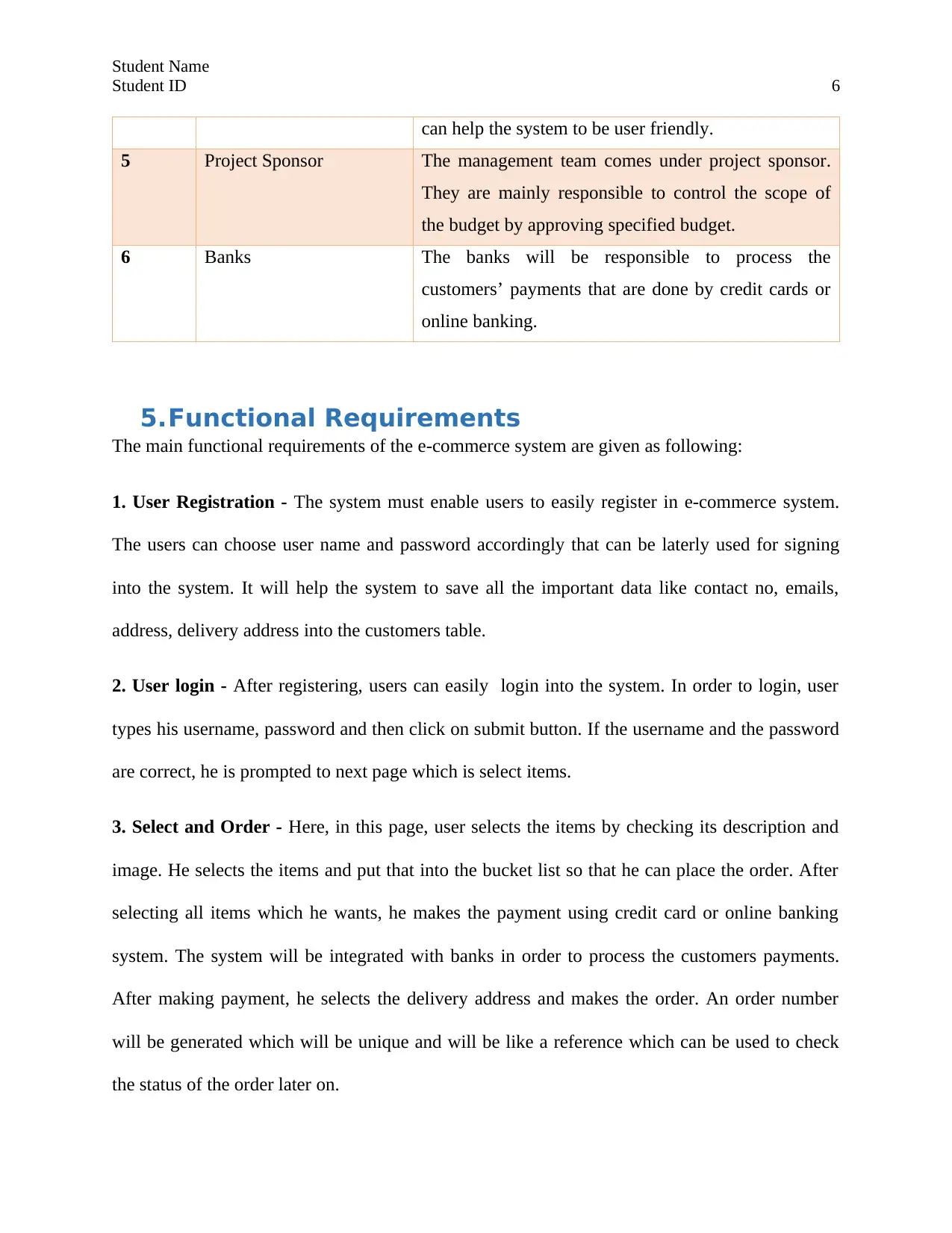
Student Name
Student ID 6
can help the system to be user friendly.
5 Project Sponsor The management team comes under project sponsor.
They are mainly responsible to control the scope of
the budget by approving specified budget.
6 Banks The banks will be responsible to process the
customers’ payments that are done by credit cards or
online banking.
5.Functional Requirements
The main functional requirements of the e-commerce system are given as following:
1. User Registration - The system must enable users to easily register in e-commerce system.
The users can choose user name and password accordingly that can be laterly used for signing
into the system. It will help the system to save all the important data like contact no, emails,
address, delivery address into the customers table.
2. User login - After registering, users can easily login into the system. In order to login, user
types his username, password and then click on submit button. If the username and the password
are correct, he is prompted to next page which is select items.
3. Select and Order - Here, in this page, user selects the items by checking its description and
image. He selects the items and put that into the bucket list so that he can place the order. After
selecting all items which he wants, he makes the payment using credit card or online banking
system. The system will be integrated with banks in order to process the customers payments.
After making payment, he selects the delivery address and makes the order. An order number
will be generated which will be unique and will be like a reference which can be used to check
the status of the order later on.
Student ID 6
can help the system to be user friendly.
5 Project Sponsor The management team comes under project sponsor.
They are mainly responsible to control the scope of
the budget by approving specified budget.
6 Banks The banks will be responsible to process the
customers’ payments that are done by credit cards or
online banking.
5.Functional Requirements
The main functional requirements of the e-commerce system are given as following:
1. User Registration - The system must enable users to easily register in e-commerce system.
The users can choose user name and password accordingly that can be laterly used for signing
into the system. It will help the system to save all the important data like contact no, emails,
address, delivery address into the customers table.
2. User login - After registering, users can easily login into the system. In order to login, user
types his username, password and then click on submit button. If the username and the password
are correct, he is prompted to next page which is select items.
3. Select and Order - Here, in this page, user selects the items by checking its description and
image. He selects the items and put that into the bucket list so that he can place the order. After
selecting all items which he wants, he makes the payment using credit card or online banking
system. The system will be integrated with banks in order to process the customers payments.
After making payment, he selects the delivery address and makes the order. An order number
will be generated which will be unique and will be like a reference which can be used to check
the status of the order later on.
⊘ This is a preview!⊘
Do you want full access?
Subscribe today to unlock all pages.

Trusted by 1+ million students worldwide
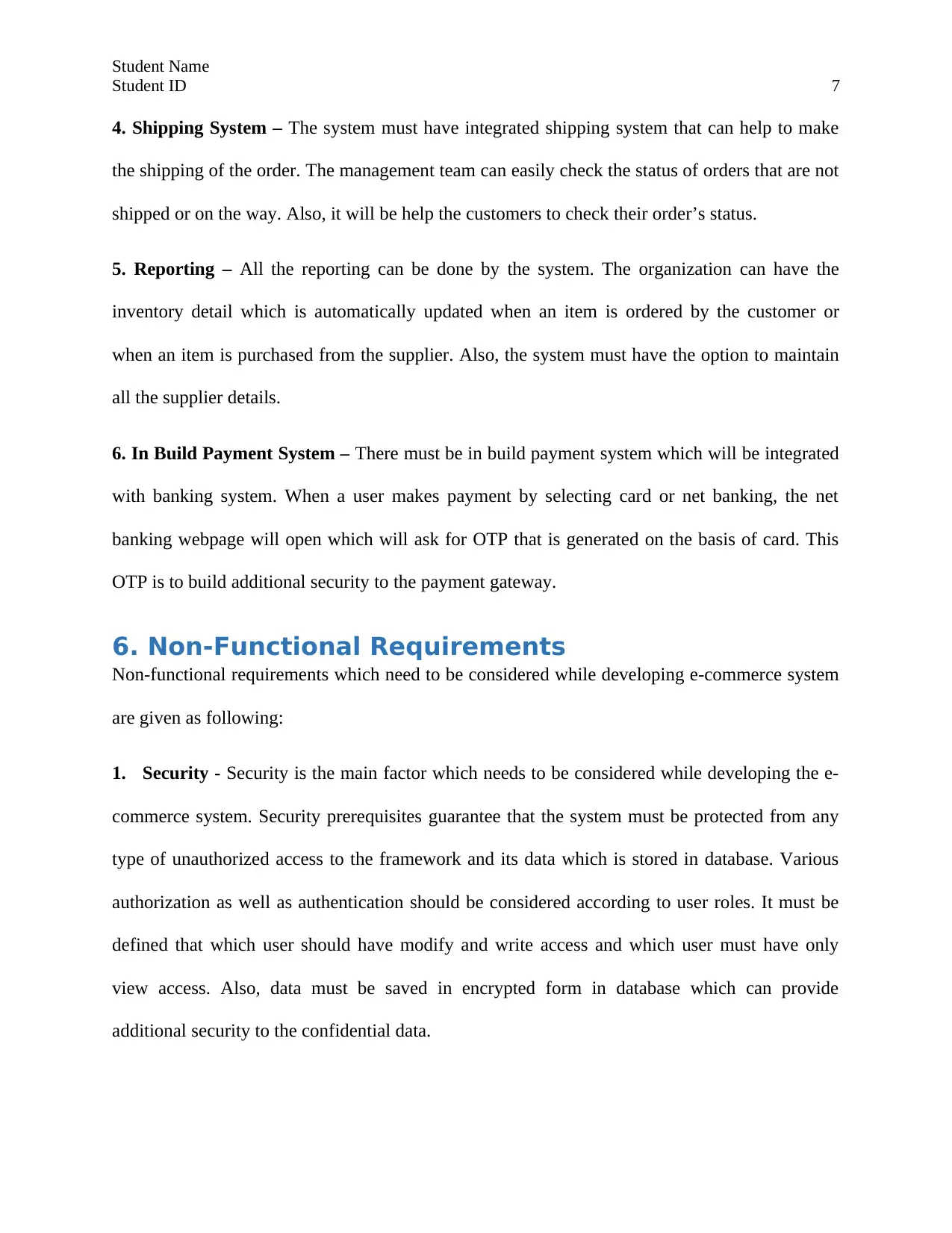
Student Name
Student ID 7
4. Shipping System – The system must have integrated shipping system that can help to make
the shipping of the order. The management team can easily check the status of orders that are not
shipped or on the way. Also, it will be help the customers to check their order’s status.
5. Reporting – All the reporting can be done by the system. The organization can have the
inventory detail which is automatically updated when an item is ordered by the customer or
when an item is purchased from the supplier. Also, the system must have the option to maintain
all the supplier details.
6. In Build Payment System – There must be in build payment system which will be integrated
with banking system. When a user makes payment by selecting card or net banking, the net
banking webpage will open which will ask for OTP that is generated on the basis of card. This
OTP is to build additional security to the payment gateway.
6. Non-Functional Requirements
Non-functional requirements which need to be considered while developing e-commerce system
are given as following:
1. Security - Security is the main factor which needs to be considered while developing the e-
commerce system. Security prerequisites guarantee that the system must be protected from any
type of unauthorized access to the framework and its data which is stored in database. Various
authorization as well as authentication should be considered according to user roles. It must be
defined that which user should have modify and write access and which user must have only
view access. Also, data must be saved in encrypted form in database which can provide
additional security to the confidential data.
Student ID 7
4. Shipping System – The system must have integrated shipping system that can help to make
the shipping of the order. The management team can easily check the status of orders that are not
shipped or on the way. Also, it will be help the customers to check their order’s status.
5. Reporting – All the reporting can be done by the system. The organization can have the
inventory detail which is automatically updated when an item is ordered by the customer or
when an item is purchased from the supplier. Also, the system must have the option to maintain
all the supplier details.
6. In Build Payment System – There must be in build payment system which will be integrated
with banking system. When a user makes payment by selecting card or net banking, the net
banking webpage will open which will ask for OTP that is generated on the basis of card. This
OTP is to build additional security to the payment gateway.
6. Non-Functional Requirements
Non-functional requirements which need to be considered while developing e-commerce system
are given as following:
1. Security - Security is the main factor which needs to be considered while developing the e-
commerce system. Security prerequisites guarantee that the system must be protected from any
type of unauthorized access to the framework and its data which is stored in database. Various
authorization as well as authentication should be considered according to user roles. It must be
defined that which user should have modify and write access and which user must have only
view access. Also, data must be saved in encrypted form in database which can provide
additional security to the confidential data.
Paraphrase This Document
Need a fresh take? Get an instant paraphrase of this document with our AI Paraphraser
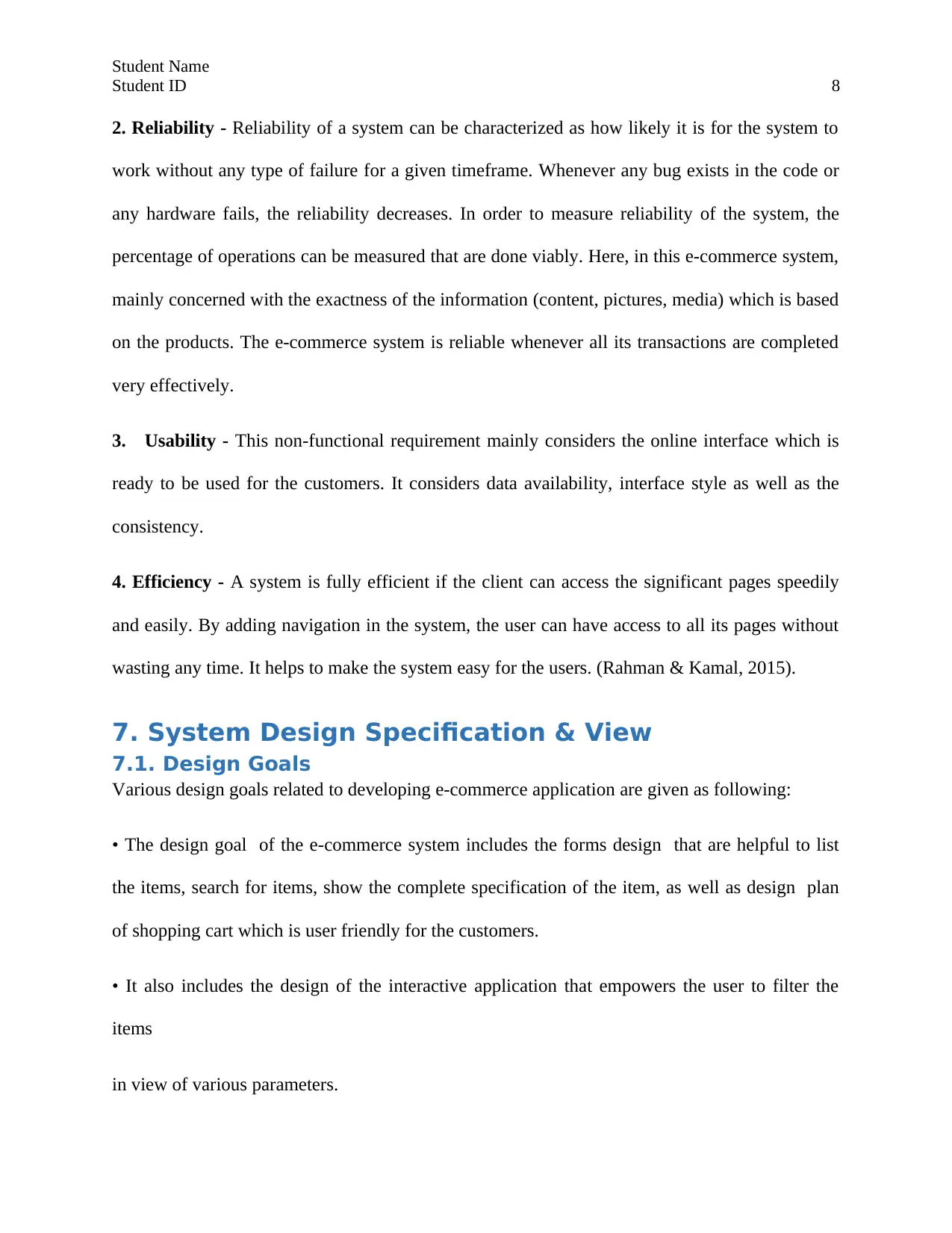
Student Name
Student ID 8
2. Reliability - Reliability of a system can be characterized as how likely it is for the system to
work without any type of failure for a given timeframe. Whenever any bug exists in the code or
any hardware fails, the reliability decreases. In order to measure reliability of the system, the
percentage of operations can be measured that are done viably. Here, in this e-commerce system,
mainly concerned with the exactness of the information (content, pictures, media) which is based
on the products. The e-commerce system is reliable whenever all its transactions are completed
very effectively.
3. Usability - This non-functional requirement mainly considers the online interface which is
ready to be used for the customers. It considers data availability, interface style as well as the
consistency.
4. Efficiency - A system is fully efficient if the client can access the significant pages speedily
and easily. By adding navigation in the system, the user can have access to all its pages without
wasting any time. It helps to make the system easy for the users. (Rahman & Kamal, 2015).
7. System Design Specification & View
7.1. Design Goals
Various design goals related to developing e-commerce application are given as following:
• The design goal of the e-commerce system includes the forms design that are helpful to list
the items, search for items, show the complete specification of the item, as well as design plan
of shopping cart which is user friendly for the customers.
• It also includes the design of the interactive application that empowers the user to filter the
items
in view of various parameters.
Student ID 8
2. Reliability - Reliability of a system can be characterized as how likely it is for the system to
work without any type of failure for a given timeframe. Whenever any bug exists in the code or
any hardware fails, the reliability decreases. In order to measure reliability of the system, the
percentage of operations can be measured that are done viably. Here, in this e-commerce system,
mainly concerned with the exactness of the information (content, pictures, media) which is based
on the products. The e-commerce system is reliable whenever all its transactions are completed
very effectively.
3. Usability - This non-functional requirement mainly considers the online interface which is
ready to be used for the customers. It considers data availability, interface style as well as the
consistency.
4. Efficiency - A system is fully efficient if the client can access the significant pages speedily
and easily. By adding navigation in the system, the user can have access to all its pages without
wasting any time. It helps to make the system easy for the users. (Rahman & Kamal, 2015).
7. System Design Specification & View
7.1. Design Goals
Various design goals related to developing e-commerce application are given as following:
• The design goal of the e-commerce system includes the forms design that are helpful to list
the items, search for items, show the complete specification of the item, as well as design plan
of shopping cart which is user friendly for the customers.
• It also includes the design of the interactive application that empowers the user to filter the
items
in view of various parameters.
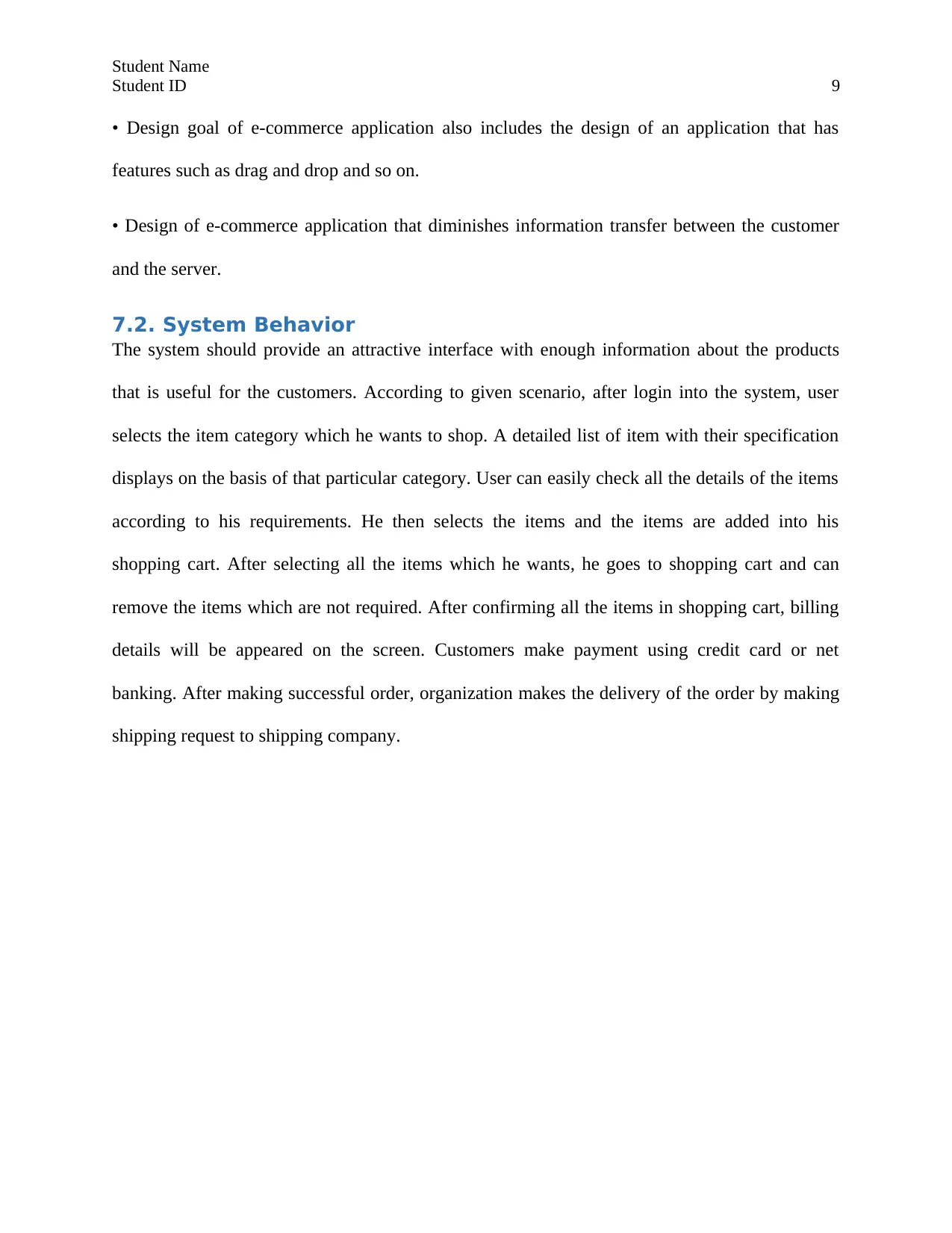
Student Name
Student ID 9
• Design goal of e-commerce application also includes the design of an application that has
features such as drag and drop and so on.
• Design of e-commerce application that diminishes information transfer between the customer
and the server.
7.2. System Behavior
The system should provide an attractive interface with enough information about the products
that is useful for the customers. According to given scenario, after login into the system, user
selects the item category which he wants to shop. A detailed list of item with their specification
displays on the basis of that particular category. User can easily check all the details of the items
according to his requirements. He then selects the items and the items are added into his
shopping cart. After selecting all the items which he wants, he goes to shopping cart and can
remove the items which are not required. After confirming all the items in shopping cart, billing
details will be appeared on the screen. Customers make payment using credit card or net
banking. After making successful order, organization makes the delivery of the order by making
shipping request to shipping company.
Student ID 9
• Design goal of e-commerce application also includes the design of an application that has
features such as drag and drop and so on.
• Design of e-commerce application that diminishes information transfer between the customer
and the server.
7.2. System Behavior
The system should provide an attractive interface with enough information about the products
that is useful for the customers. According to given scenario, after login into the system, user
selects the item category which he wants to shop. A detailed list of item with their specification
displays on the basis of that particular category. User can easily check all the details of the items
according to his requirements. He then selects the items and the items are added into his
shopping cart. After selecting all the items which he wants, he goes to shopping cart and can
remove the items which are not required. After confirming all the items in shopping cart, billing
details will be appeared on the screen. Customers make payment using credit card or net
banking. After making successful order, organization makes the delivery of the order by making
shipping request to shipping company.
⊘ This is a preview!⊘
Do you want full access?
Subscribe today to unlock all pages.

Trusted by 1+ million students worldwide
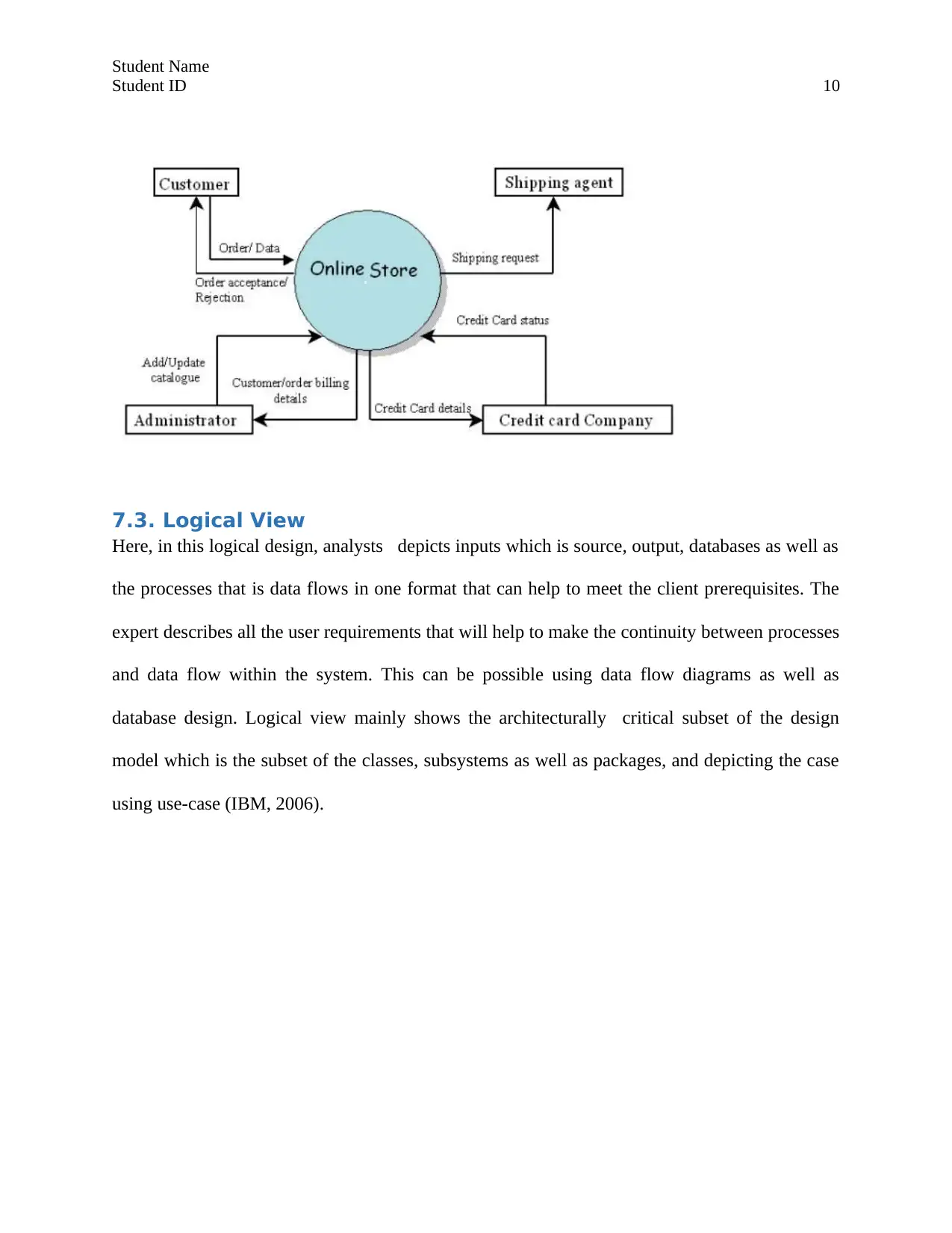
Student Name
Student ID 10
7.3. Logical View
Here, in this logical design, analysts depicts inputs which is source, output, databases as well as
the processes that is data flows in one format that can help to meet the client prerequisites. The
expert describes all the user requirements that will help to make the continuity between processes
and data flow within the system. This can be possible using data flow diagrams as well as
database design. Logical view mainly shows the architecturally critical subset of the design
model which is the subset of the classes, subsystems as well as packages, and depicting the case
using use-case (IBM, 2006).
Student ID 10
7.3. Logical View
Here, in this logical design, analysts depicts inputs which is source, output, databases as well as
the processes that is data flows in one format that can help to meet the client prerequisites. The
expert describes all the user requirements that will help to make the continuity between processes
and data flow within the system. This can be possible using data flow diagrams as well as
database design. Logical view mainly shows the architecturally critical subset of the design
model which is the subset of the classes, subsystems as well as packages, and depicting the case
using use-case (IBM, 2006).
Paraphrase This Document
Need a fresh take? Get an instant paraphrase of this document with our AI Paraphraser
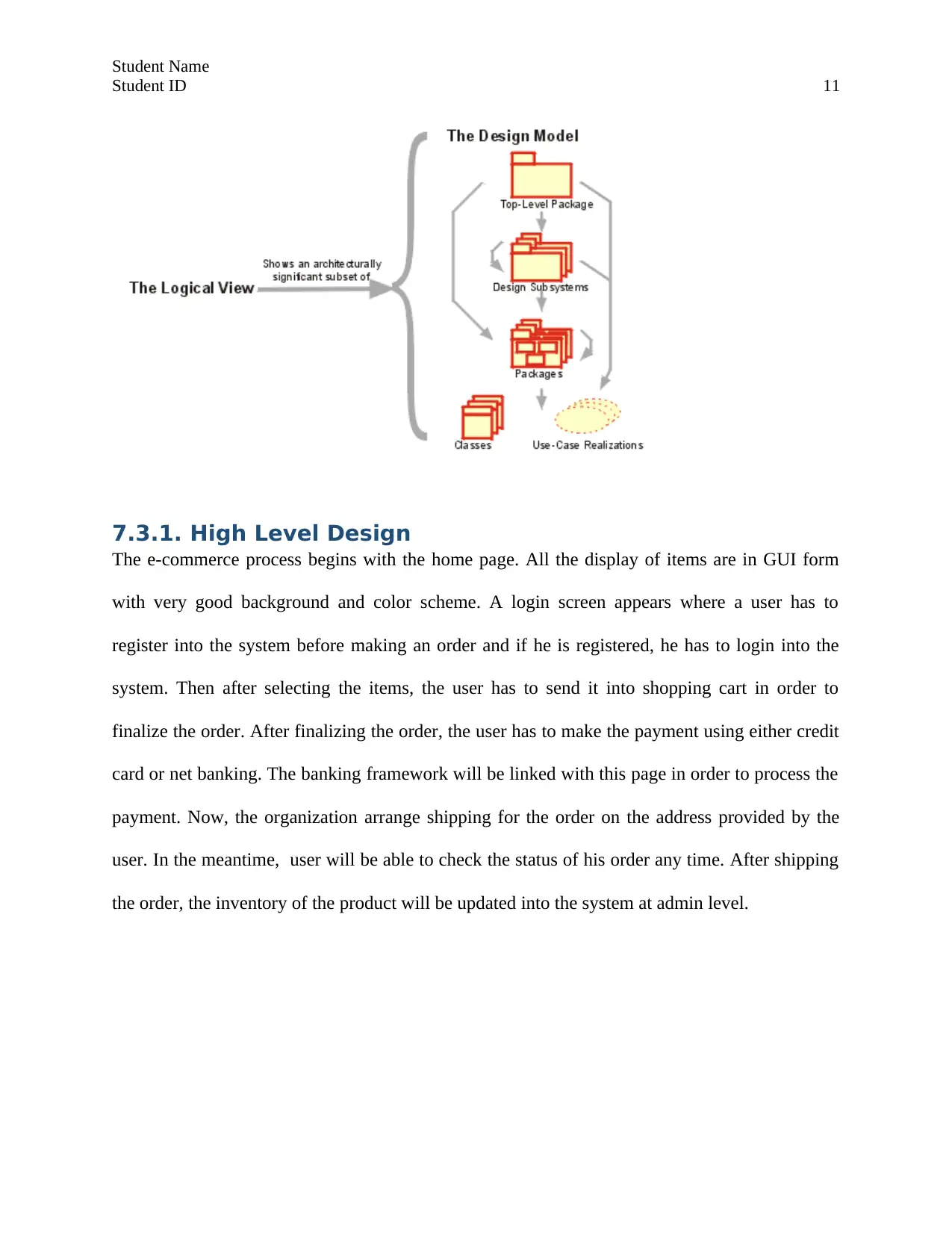
Student Name
Student ID 11
7.3.1. High Level Design
The e-commerce process begins with the home page. All the display of items are in GUI form
with very good background and color scheme. A login screen appears where a user has to
register into the system before making an order and if he is registered, he has to login into the
system. Then after selecting the items, the user has to send it into shopping cart in order to
finalize the order. After finalizing the order, the user has to make the payment using either credit
card or net banking. The banking framework will be linked with this page in order to process the
payment. Now, the organization arrange shipping for the order on the address provided by the
user. In the meantime, user will be able to check the status of his order any time. After shipping
the order, the inventory of the product will be updated into the system at admin level.
Student ID 11
7.3.1. High Level Design
The e-commerce process begins with the home page. All the display of items are in GUI form
with very good background and color scheme. A login screen appears where a user has to
register into the system before making an order and if he is registered, he has to login into the
system. Then after selecting the items, the user has to send it into shopping cart in order to
finalize the order. After finalizing the order, the user has to make the payment using either credit
card or net banking. The banking framework will be linked with this page in order to process the
payment. Now, the organization arrange shipping for the order on the address provided by the
user. In the meantime, user will be able to check the status of his order any time. After shipping
the order, the inventory of the product will be updated into the system at admin level.
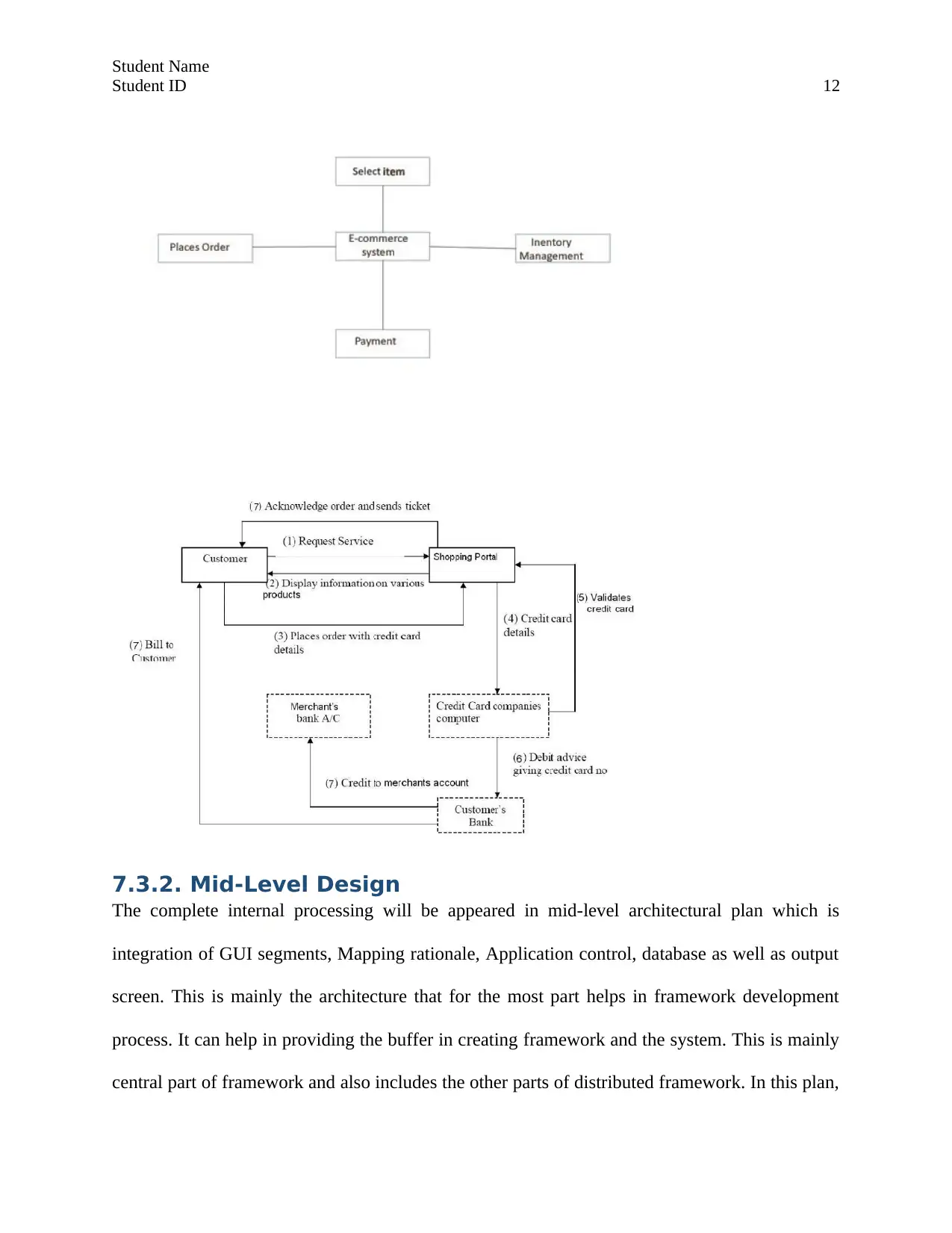
Student Name
Student ID 12
7.3.2. Mid-Level Design
The complete internal processing will be appeared in mid-level architectural plan which is
integration of GUI segments, Mapping rationale, Application control, database as well as output
screen. This is mainly the architecture that for the most part helps in framework development
process. It can help in providing the buffer in creating framework and the system. This is mainly
central part of framework and also includes the other parts of distributed framework. In this plan,
Student ID 12
7.3.2. Mid-Level Design
The complete internal processing will be appeared in mid-level architectural plan which is
integration of GUI segments, Mapping rationale, Application control, database as well as output
screen. This is mainly the architecture that for the most part helps in framework development
process. It can help in providing the buffer in creating framework and the system. This is mainly
central part of framework and also includes the other parts of distributed framework. In this plan,
⊘ This is a preview!⊘
Do you want full access?
Subscribe today to unlock all pages.

Trusted by 1+ million students worldwide
1 out of 25
Related Documents
Your All-in-One AI-Powered Toolkit for Academic Success.
+13062052269
info@desklib.com
Available 24*7 on WhatsApp / Email
![[object Object]](/_next/static/media/star-bottom.7253800d.svg)
Unlock your academic potential
Copyright © 2020–2025 A2Z Services. All Rights Reserved. Developed and managed by ZUCOL.




